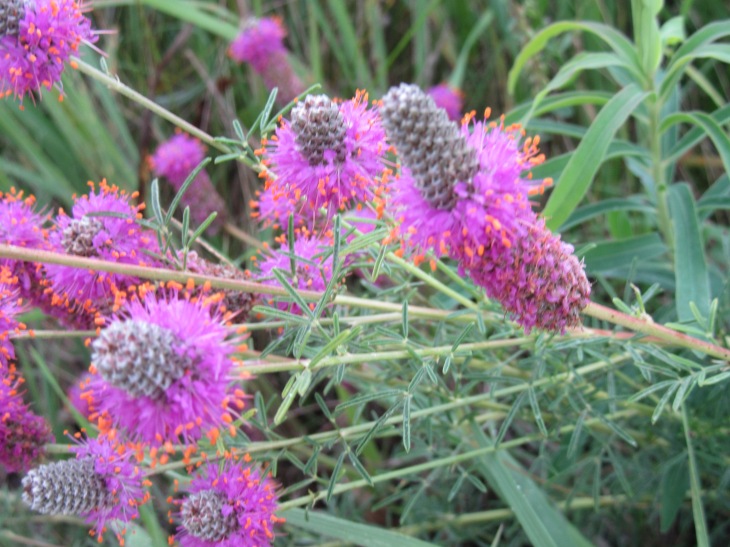After dinner, last night, my 25-year-old son and I decided to take a hike today. Ordinarily, he would not be home and available to do such a thing, but in times of COVID, one must improvise. I felt the hike would do us both some good and suggested the Prairie’s Edge Loop Trail at the Trempealeau Wildlife Refuge.

This wildlife refuge sits on the edge of the mighty Mississippi River in Trempealeau County – just to the north of where we live. It offers a chance to view a diverse range of wildlife that encompasses both wetlands and sand prairie. I was last to the refuge when I spoke there as a guest in 2016 on monarch butterflies and the multi-factorial cause of their diminishing numbers.
Despite having to dodge some raindrops, the hike did not disappoint! Of the 4.5 mile trail, we only walked 1.5 miles in and 1.5 miles out. It was somewhat buggy, especially near the marshy parts of the tour. But, many beautiful native prairie wildflowers were in bloom, as one would expect during the height of summer heat.
Immediately, we were greeted by native Bee Balm or Wild Bergamot, scientifically known as Monarda fistulosa.

This was quickly interspersed with common milkweed just beginning to produce pods, and whorled milkweed still in bloom. There was an abundance of both but no evidence of monarch larva, which always disappoints me. Personally, however, I love seeing the whorled milkweed because I’ve tried growing it for years and have always had trouble.

Whorled milkweed or Asclepias verticillata is native to this part of the country and as with other milkweeds sustains the monarch life cycle. It is interesting to me how different this plant appears than that of common milkweed. There was an abundance of both, lining the trail today.


In addition, we saw butterfly weed, Asclepias tuberosa, in bloom with its striking orange flower heads.

It seemed that Hoary Vervain was everywhere you looked but upon closer inspection, one could tell it was past its prime. Still, the tall purple flower spikes were noticeable as they reached over the trail in an attempt to capture some sun.


Of course, there were plant names of which I was unsure. I guessed at this horsetail which we’ve seen at our cabin in Northern Wisconsin. I am still unsure of its genus but feel it might be Equisetum hyemale or Scouring Rush Horsetail.
What’s not seen well in the photo below is the bamboo-like sections on the stem. The features of this plant make it highly noticeable, in my opinion.

In any case, it’s a creepy-looking plant. After a little reading, I found that this plant is non-flowering and does not reproduce by seeds, but instead does so with spores! I’ll reach out to some friends who are more versed in botany than I and try to verify it’s identification. But, I know like diagnosing a rash on a human, without being able to personally inspect the plant, it is sometimes difficult to obtain an accurate id.
Lastly, we saw what I believe to be Purple Prairie Clover (Dalea purpurea) shortly after our hike began in an open area that would receive many hours of sun on a clear day. It lined the trail and was striking in form and color (more red in the purple than blue).

I have never seen one of these in bloom, so finding it today was a bonus! I was pretty confident in my identification but still checked when I got home. For this confirmation, I used the Praire Plants of the University of Wisconsin – Madison Arboretum book by T.S. Cochrane, Kandis Elliot, and Claudia S. Lipke (2014), pg. 183.

This prairie walk also featured Black-eyed Susans and some other taller yellow-flowered plants that might have been Compass Plants (Silphium laciniatum) or Gray-headed Coneflowers (Ratibida pinnata).
My aim with all the prairie walks this summer include expanding my working knowledge on these native plants so I can readily identify them on sight and provide some information if I were to lead a hike in the future. It’s been an informative pleasure to see the prairie awaken and evolve over the last few months.
Being in nature has also provided a balm for the isolation that has occurred during the necessity of social distancing during the pandemic. Times and activities change, but nature welcomes and soothes. I feel blessed to be near so many beautiful places. And, doubly blessed to be able to enjoy them with my son.

Today is Slice of Life Tuesday. Thanks to TwoWritingTeachers for creating a welcoming spot for us to share our writing online.